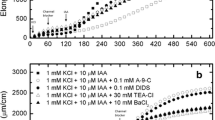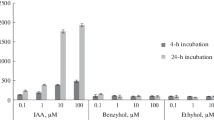Summary
-
1.
Sections of auxin-starved hypocotyls of Helianthus annuus do not show any significant growth rate in water of buffers of pH\>-6. However, in buffers with pH-values of approximately 4, elongation growth is observed; its rate is similar to the rate of auxin-stimulated growth (after 6 h incubation). \3- This phenomenon of acid-induced growth occurs also under anaerobic conditions in contrast to auxin-induced growth (Hager 1962).
-
2.
Intact cell wall aggregates of Helianthus hypocotyls were obtained by complete plasmolysis of hypocotyls in 50% glycerol; cell wall associated enzymes were still active after this treatment, at least in part. While cell walls in solutions of pH\>-6 show only a small plastic extension during the first minute in response to a 50 g stretching force, a constant rate of elongation over longer periods of time (measured up to 1 h) is observed in weakly acid buffers. The highest rate of elongation is observed at about pH 4.
This acid-induced plastic extension is completely inhibited by Cu2+-ions (5mM); the elongation of cell walls is apparently the consequence of an enzyme-catalysed increase in plasticity having a pH optimum of about 4.
The pH optimum of acid-induced cell wall extension observed during stretching of plasmolysed hypocotyls coincides with the pH optimum of acid-induced growth of intact hypocotyl sections (around pH 4).
-
3.
Under anaerobic conditions the growth rate of intact coleoptiles stays unchanged (at a low value) if the sections are incubated in a buffer of pH 5.0. Higher proton concentrations, however, stimulate growth immediately, whereas low proton concentrations are inhibitory (Fig. 7 and 8). The strongest initial growth response is elicited by buffers or acids of pH 3.9 (Fig. 9). Acid-induced growth of coleoptiles with a similar pH optimum is also found under anaerobic conditions.
The growth of coleoptile cylinders can be switched on or off by repeatedly changing to acid or basic medium, respectively (under conditions of anaerobiosis) (Fig. 10).
IAA-induced growth (aerobic conditions, pH≥5) can also be inhibited immediately by basic buffers or NaOH-solutions, and resumes after the pH value is lowered (Fig. 11). This pH-dependency may be taken as an indication that auxin affects the same reaction which is stimulated by high proton concentrations and which may be the last step in the process of cell elongation.
CCCP, known to make membranes permeable for protons, rapidly inhibits the auxin-induced elongation growth (pH 6,5) when applied at a concentration which does not influence respiration; removal of CCCP shows that the growth inhibition by CCCp is partly reversible (Fig. 12). In contrast, acid-induced elongation growth (pH 4) shows inhibition by CCCP not before 10 min after application.—These findings suggest that auxin induces a proton accumulation in a cell wall compartment and, as a consequence, enzymatic cell wall softening. Such an accumulation could be brought about by an auxin-activated, membrane-bound, anisotropic ATPase or ion pump.
The notion that ATPases or pumps may be located in the outer layers of the cell membrane is supported by the observation that addition of ATP to coleoptile cylinders under anaerobic conditions results in an immediate stimulation of elongation (Fig. 14). This effect is further enhanced by Mg2+-and K+-ions (Figs. 15 and 16). Mg2+ can be partly replaced by Ca2+. The stimulatory effect of ATP is increased considerably if the coleoptiles are treated with IAA under aerobic conditions prior to ATP addition (Figs. 15 b and 14). ITP, GTP, UTP, and CTP induce elongation growth under anaerobiosis similarly to ATP. In the presence of ITP or GTP the increase in growth rate is maintained over a longer period of time than in the presence of the other nucleoside triphosphates (Fig. 17).
IAA, which causes no elongation growth under anaerobiosis (Fig. 13) is also unable to further stimulate the elongation growth induced by ATP, UTP, or CTP under anaerobiosis (Fig. 18); however, if IAA is added after growth has been stimulated by GTP or ITP, a temporary inhibition and, 10 min later, a strong stimulation is noticed (Fig. 19). If the sequence of addition is reversed, —that is, if IAA (without growth effect) and, after 20 min, GTP or ITP are added to the coleoptiles—, the same initial inhibition and subsequent increase of the growth rate is found (Fig. 20).
Thus, IAA can stimulate growth of coleoptiles even under anaerobic conditions if GTP or ITP is present at the same time.
-
4.
The results support the following hypothesis (Fig. 21): auxin acts cooperatively with GTP (ITP) as an effector of a membrane-bound, anisotropic ATPase or proton pump. This pump, activated by auxin, utilizes respiration energy (ATP or other nucleoside triphosphates) to raise the proton concentration in a compartment at the cell wall. This event leads to an increase in the activity of enzymes softening cell walls and thus triggers cell elongation. The transport or secretion of protons into the cell wall compartment should be compensated by a flow of cations into the interior of the cytoplasm or by a flow of anions to the cell periphery, thus causing secondary auxin effects.
Similar content being viewed by others
Literatur
Armstrong, D.J.: Hypothesis concerning the mechanism of auxin action. Proc. nat. Acad. Sci. (Wash.) 56, 64–66 (1966).
Bonner, J.: The relation of hydrogen ions to the growth rate of the Avena coleoptile. Protoplasma (Wien) 21, 406–423 (1934).
Brauner, L., Brauner, M.: The relation between water intake and oxybiosis in living plant tissue. II. The tensility of the cell wall. Rev. Fac. Sci. Istanbul, Sér. B 8, 30–70 (1943).
—, Hasman, M.: Weitere Untersuchungen über den Wirkungsmechanismus des Heteroauxins bei der Wasseraufnahme von Pflanzenparenchym. Protoplasma (Wien) 41, 302–326 (1952).
Cleland, R.: Extensibility of isolated cell walls. Planta (Berl.) 74, 197–209 (1967).
Ellis, R. J., MacDonald, I. R.: Specificity of cycloheximide in higher plant systems. Plant Physiol. 46, 227–232 (1970).
Hager, A.: Untersuchungen über einen durch H+-Ionen induzierbaren Zellstrekkungsmechanismus. Habil.-Schr., Naturw. Fakultät Univ. München (1962).
—: Das geotropische “Gedächtnis” der Pflanzen. In: Wachstumsregulatoren bein Pflanzen, p. 549–558. Intern. Vortragstagung Rostock/Kühlungsborn (1966). Jena: VEB Fischer 1967.
—: Lichtbedingte pH-Erniedrigung in einem Chloroplasten-Kompartiment als Ursache der enzymatischen Violaxanthin→Zeaxanthin-Umwandlung. Beziehungen zur Photophosphorylierung. Planta (Berl.) 89, 224–243 (1969).
Hager, A., Schmidt, R.: Auxintransport und Phototropismus. I. Die lichtbedingte Bildung eines Hemmstoffes für den Transport von Wuchsstoffen in Koleoptilen. Planta (Berl.) 83, 347–371 (1968a).
——: Auxintransport und Phototropismus. II. Der Hemmechanismus des aus IES gebildeten Photooxidationsproduktes 3-Methylenoxindol beim Transport von Wuchsstoffen. Planta (Berl.) 83, 372–386 (1968).
Hertel, R., Evans, M. L., Leopold, A. C., Seil, H. M.: The specificity of the auxin transport system. Planta (Berl.) 85, 238–249 (1969).
Masuda, Y., Kamisaka, S.: Rapid stimulation of RNA biosynthesis by auxin. Plant and Cell Physiol 10, 79–86 (1969).
Menzel, H.: Die pH-abhängige Veränderung mechanischer und chemischer Eigenschaften der Zellwand und ihr Zusammenhang mit der Wuchsstoffwirkung. Dissertation, Naturw. Fakultät, Univ. München (1966).
Mitchell, P.: Proton-translocation phosphorylation in mitochondria, chloroplasts and bacteria; natural fuel cells and solar cells. Fed. Proc. 26, 1370–1379 (1967).
Nelson, H., Ilan, J., Reinhold, L.: The effect of inhibition of protein and RNA synthesis on auxin-induced growth. Israel J. Botany 18, 129–134 (1969).
Nissl, D., Zenk, M. H.: Evidence against induction of protein synthesis during auxin-induced initial elongation of Avena coleoptiles. Planta (Berl.) 89, 323–341 (1969).
Nitsch, J. P., Nitsch, C.: Studies on the growth of coleoptile and first internode sections. A new, sensitive, straight-growth test for auxins. Plant Physiol. 31, 94–111 (1956).
Penny, P., Galston, A. W.: The kinetics of inhibition of auxin-induced growth in green pea stem segments by actinomycin D and other substances. Amer. J. Bot. 53, 1–7 (1966).
Pohl, R.: Ein Beitrag zur Analyse des Streckungswachstums der Pflanzen. Planta (Berl.) 36, 230–261 (1949).
Ray, P. M., Ruesink, A. W.: Kinetic experiments on the nature of the growth mechanism in oat coleoptile cells. Develop. Biol. 4, 377–397 (1962).
Rayle, D. L., Cleland, R.: Enhancement of wall loosening and elongation. Plant Physiol. 46, 250–253 (1970).
—, Evans, M. L., Hertel, R.: Action of auxin on cell elongation. Proc. nat. Acad. Sci. (Wash.) 65, 184–191 (1970).
—, Haughton, P. M., Cleland, R.: An in vitro system that simulates plant cell extension growth. Proc. nat. Acad. Sci. (Wash.) 67, 1814–1817 (1970a).
Reilly, C., Fuhrmann, G. F., Rothstein, A.: The inhibition of K+ and phosphate uptake in yeast by cycloheximide. Biochim. biophys. Acta (Amst.) 203, 583–585 (1970).
Santen, A. M. A. van: Groei, groeistof en pH. Diss. Utrecht 1940.
Segal, L.: Schädigende und fördernde Einflüsse von Säuren und Puffergemischen auf das Streckungswachstum. Biol. Zbl. 79, 321–336 (1960).
Strugger, S.: Die Beeinflussung des Wachstums und des Geotropismus durch die Wasserstoffionen. Ber. dtsch. bot. Ges. 50, Anhang, 77–92 (1932).
Zenk, M.: Wachstum. Fortschr. Bot. 29, 123–143 (1967).
Author information
Authors and Affiliations
Rights and permissions
About this article
Cite this article
Hager, A., Menzel, H. & Krauss, A. Versuche und Hypothese zur Primärwirkung des Auxins beim Streckungswachstum. Planta 100, 47–75 (1971). https://doi.org/10.1007/BF00386886
Received:
Issue Date:
DOI: https://doi.org/10.1007/BF00386886




